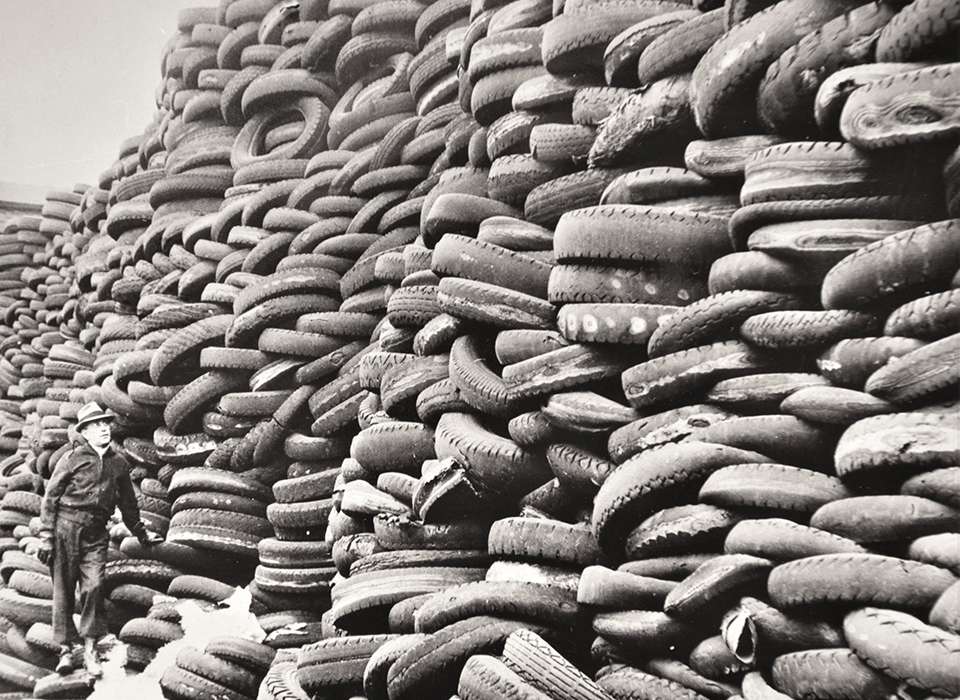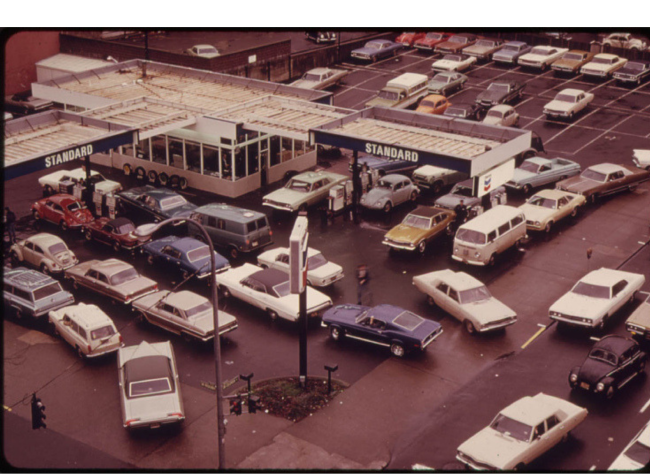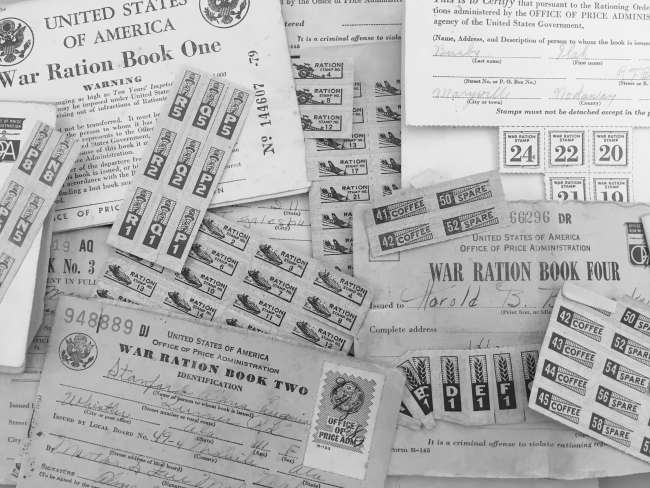Top Image: A mountain of used automobile tires stands ready for wartime reclamation. Courtesy National Archives.
America had fully embraced the automobile by the dawn of the 1940s. As of 1941, about 88 percent of US households had a family car and that number was rising. A 1942 model Ford Super Deluxe two-door sedan cost around $920 brand new, roughly one third of an average yearly income. The fast, heavy, and new Ford was introduced on September 12, 1941, less than three months before the attack on Pearl Harbor. It would be part of the last group of new vehicles most of the public would see for years.
Ford made 691,455 automobiles in 1941. Yet they only built around 160,000 vehicles for civilians in 1942, before Ford’s non-military car and truck lines ceased operations on February 10. The government then stockpiled remaining unsold cars and rationed them to those individuals deemed critical to public safety and the war effort—doctors, police and firefighters, farmers, and a rare handful of vital war workers. To be eligible for a new car, a person had to possess an older car with more than 40,000 miles on the odometer.
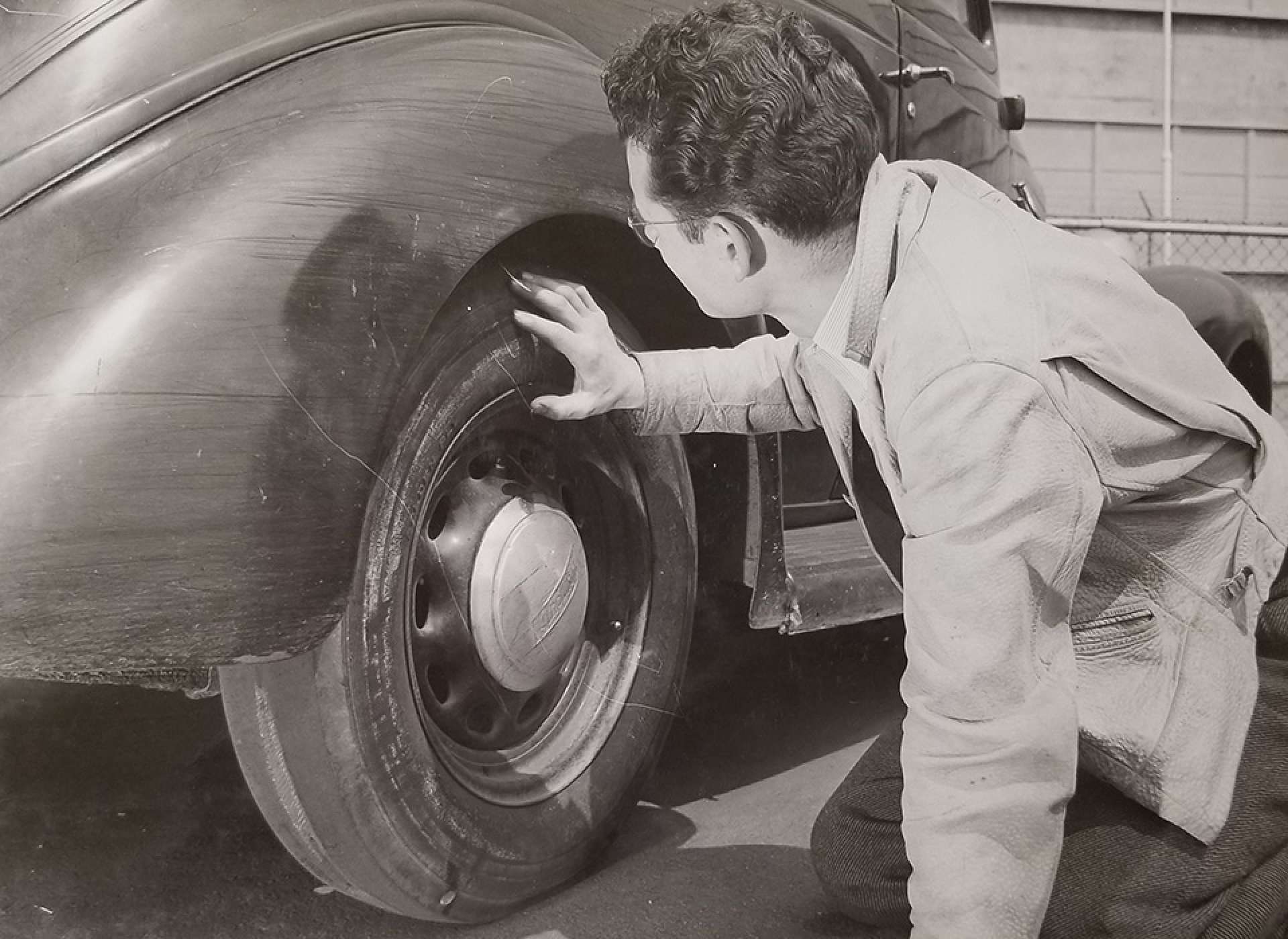
In June of 1942, a worker at the Vega Aircraft Corporation plant inspects his already balding tires. He lives 10 miles from the factory. Courtesy Library of Congress.
Automobile companies continued to make cars and trucks for the government while dramatically broadening their output to include military weapons such as tanks, engines, cannons, trucks, and aircraft. In truth, America’s auto industry had been living a double life for two years. They had supplied civilian vehicles for the nation’s growing car culture, all while increasing their weapons-producing capacity to serve a massive Allied build-up. Full entry into World War II in December 1941 was, in some ways, a relief to the US automobile industry, because it was freed from having to both serve civilian and military needs simultaneously.
While America’s auto companies now turned exclusively to war production, the average citizen was left with the vehicle they possessed when the fighting started, or what they could scrounge up through legal or “more creative” means.
For the war years, spare parts and fuel would be limited, but the most painful automobile-related issue was tires. Soon after Pearl Harbor, Japan seized control of the Dutch East Indies (Indonesia) and British Malaya (Malaysia), cutting off roughly 90 to 95 percent of America’s natural rubber supply. What was left was quickly consumed for the US war effort. Goodyear reminded the public that while the construction of a battleship took nearly unimaginable amounts of high-grade steel, it also required more than 75 tons of rubber. Not to mention the mountains of life rafts, gas masks, jeep tires, pontoon bridges, and tank tracks going into battle.
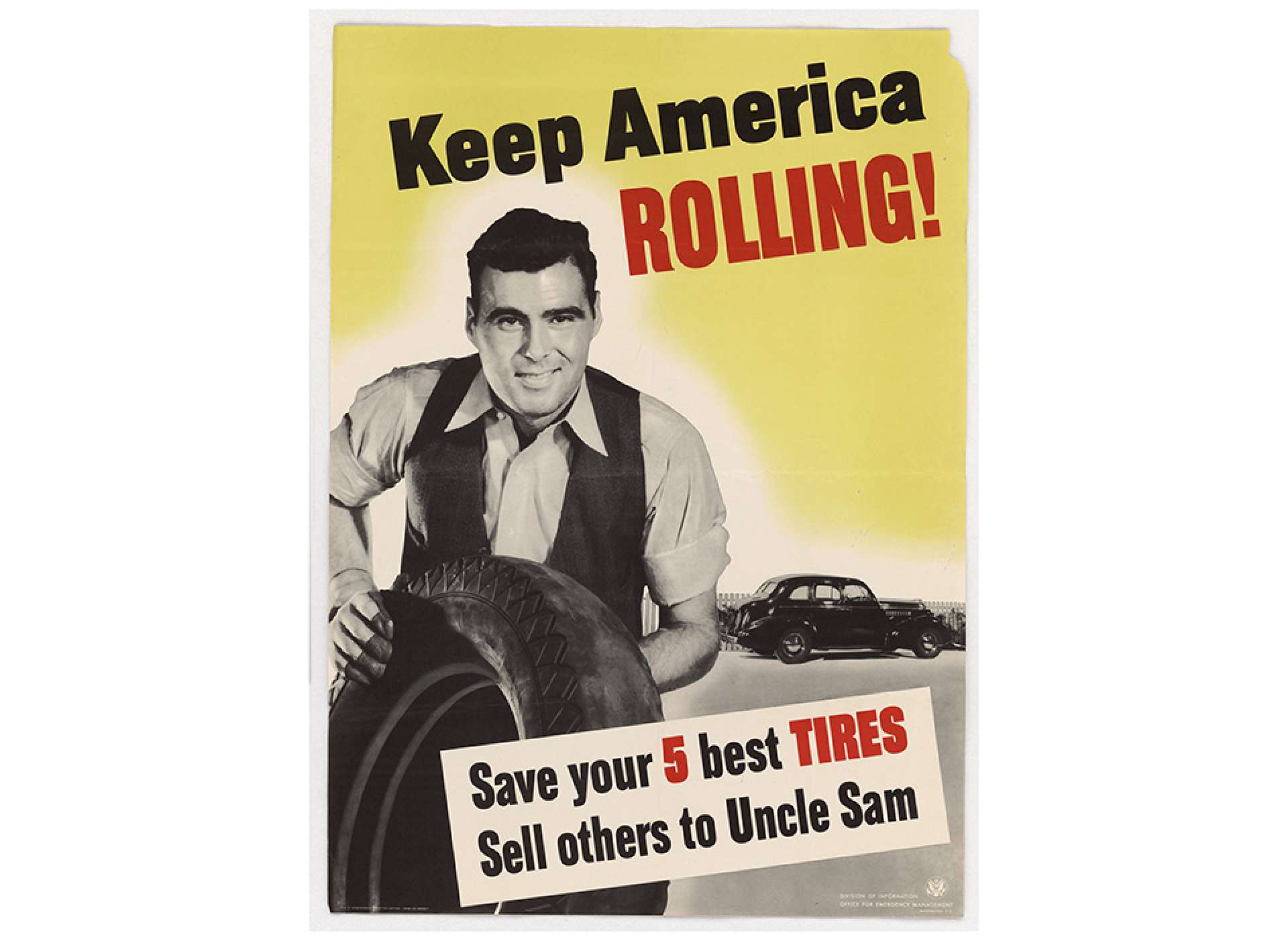
An Office of Emergency Management poster encourages people to give their extra tires to authorities. Courtesy National Archives.
Thus, automobile tires were exceedingly scarce. A civilian could keep five tires. Anything else had to be surrendered to authorities. People were sternly reminded that no one could trade, buy, or even recap tires without getting the Office of Price Administration and the local Tire Rationing Board involved in the transaction. It was as if each car-owning war worker had suddenly adopted five additional children. Great care was taken to inspect tires twice a week or more, checking air pressure, and scouting for small “cuts or bruises” in order to immediately repair them before a catastrophic failure.
Tires of the era lasted roughly two years under normal conditions. Perhaps more, but only if drivers babied them. Excessive speed, misalignment, or even abrupt stops and starts would eat rubber quickly. A big problem was improper inflation. According to the major rubber companies, a tire rated for 30 pounds of air pressure wore away 21 percent more rubber when running at 27 pounds. A tire driving at 21 pounds lasted half as long as a correctly inflated one. To help prolong tire life, production plants ran air hoses out to the parking lots to allow employees to top off.
Around April of 1942, companies painstakingly surveyed the status of their employees’ tires, finding, to their alarm, that most would not survive a year under wartime conditions. A tongue-in-cheek photo op outside Lockheed’s Plant 1 showed aircraft workers arriving in a horse-drawn buggy, which required no rubber at all.
These same surveys found that most people drove their privately-owned cars to work. The number of car-driving aircraft workers was about 77 percent nationwide. Plants on the West Coast had the highest averages. Around 80 percent of Douglas Aircraft’s 200,000 employees drove to their job. Lockheed Vega reported 91.6 percent of their workforce using private cars, clocking an average of 21.6 miles a day and gobbling up 4,000 tires a month.
At the factories, fenced-off parking areas were patrolled by guards who protected the workers’ automobiles and their precious rubber. One guard at Cessna spent his time on lot patrol dragging a powerful magnet in the gravel behind him. He proudly displayed his pile of discarded nails for the company newspaper. Cessna pressmen calculated that he may have saved 700 flats among the Kansas workforce.
But these patrols were not exclusively for protection. The company security checked windshields for up-to-date Motor Vehicle Use Tax stamps and hit suspicious-looking tires with their trusty pressure gauge. Violators, even those just a few pounds light, were given not-so-gentle reminders to fall in line.
Gasoline rationing and reduced speed limits had their roots in the preservation of rubber. “Victory Speed,” 35 miles-per-hour, was initiated nationwide in May 1942. The reduction in speed saved fuel and doubled the life of tires compared to speeds of 60 miles per hour. Victory Speed had an effect on nearly everyone, but was particularly difficult for a few factory workers in states like Kansas and Ohio, some of whom were traveling 80 miles or more to and from their jobs at Beech, Cessna, or Goodyear.
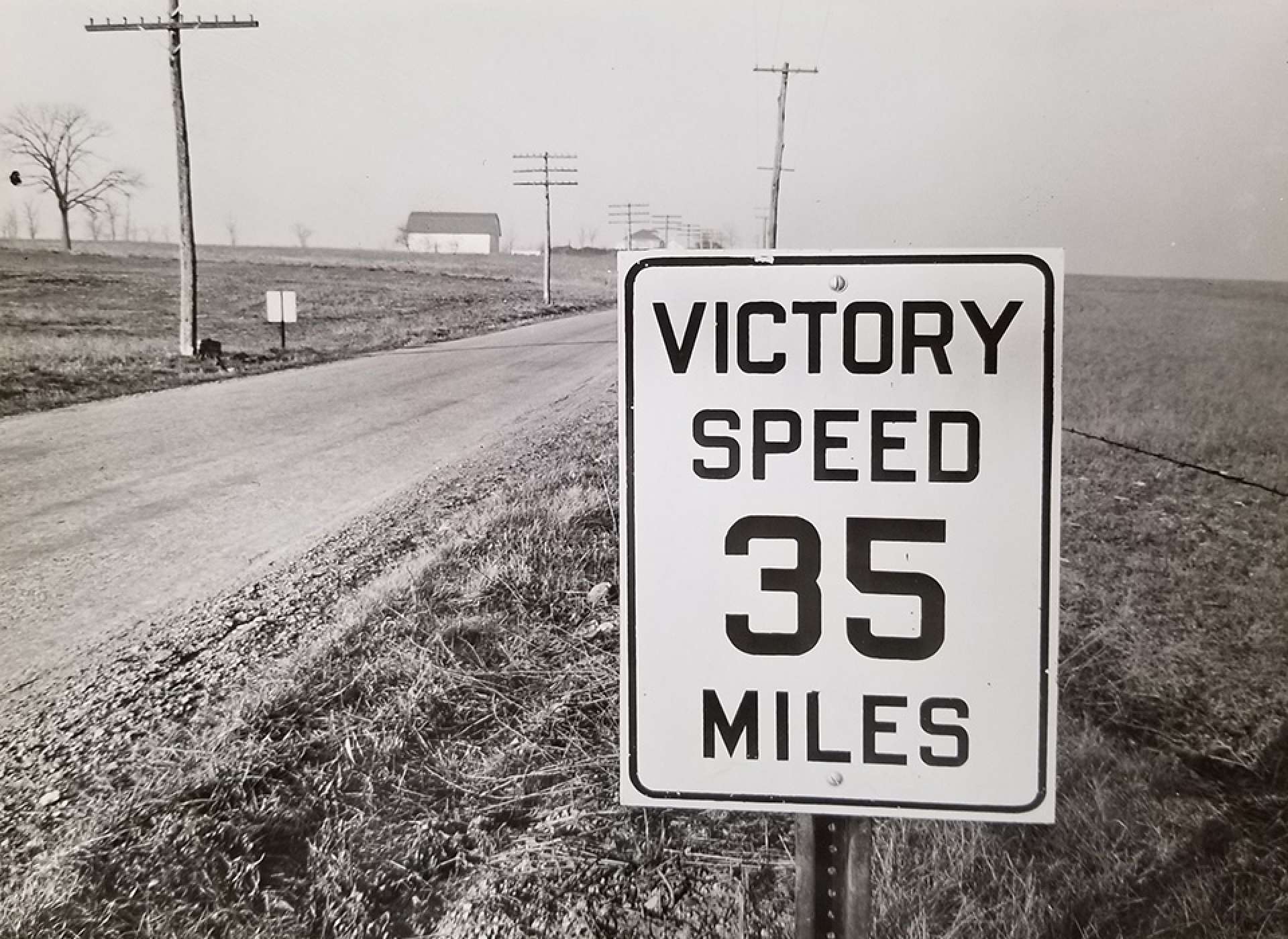
A road sign near Manheim, Pennsylvania posts the new “Victory Speed”—35 miles per hour in November of 1942. Courtesy Library of Congress.
The wartime government made it much more difficult and costly to own and operate a car, even though many complained that the restrictions were un-American. At the least, government officials demanded that car owners use their machines thoughtfully and sparingly.
Strolling the lines of cars in a lot at a factory, one would see a collection of stickers in the windshields of the parked automobiles. The biggest was a gas ration sticker emblazoned with a large block letter. X stickers, allowing for as much gas as needed, were practically non-existent around wartime plants. They were used primarily by traveling salesmen, VIPs, and politicians.
One of 17 different “war critical” jobs could get a driver a C sticker, but most of those were not found at a war plant either, at least not in great numbers. C stickers, also unlimited gas, went to those working in government, schools, medical facilities, construction, military, press, the clergy, mail delivery, and farming. Also included on the slate of tasks that could earn a C sticker were embalmer, telegram delivery, and scrap agent.
Most stickers seen at factories were A and B. Black A stickers were much more common than green B stickers. B allowed eight gallons of fuel per week. Black A stickers awarded a driver four gallons a week (in most regions). At a filling station, a driver was expected to turn over the proper number of ration stamps and money, in exchange for precious gas.
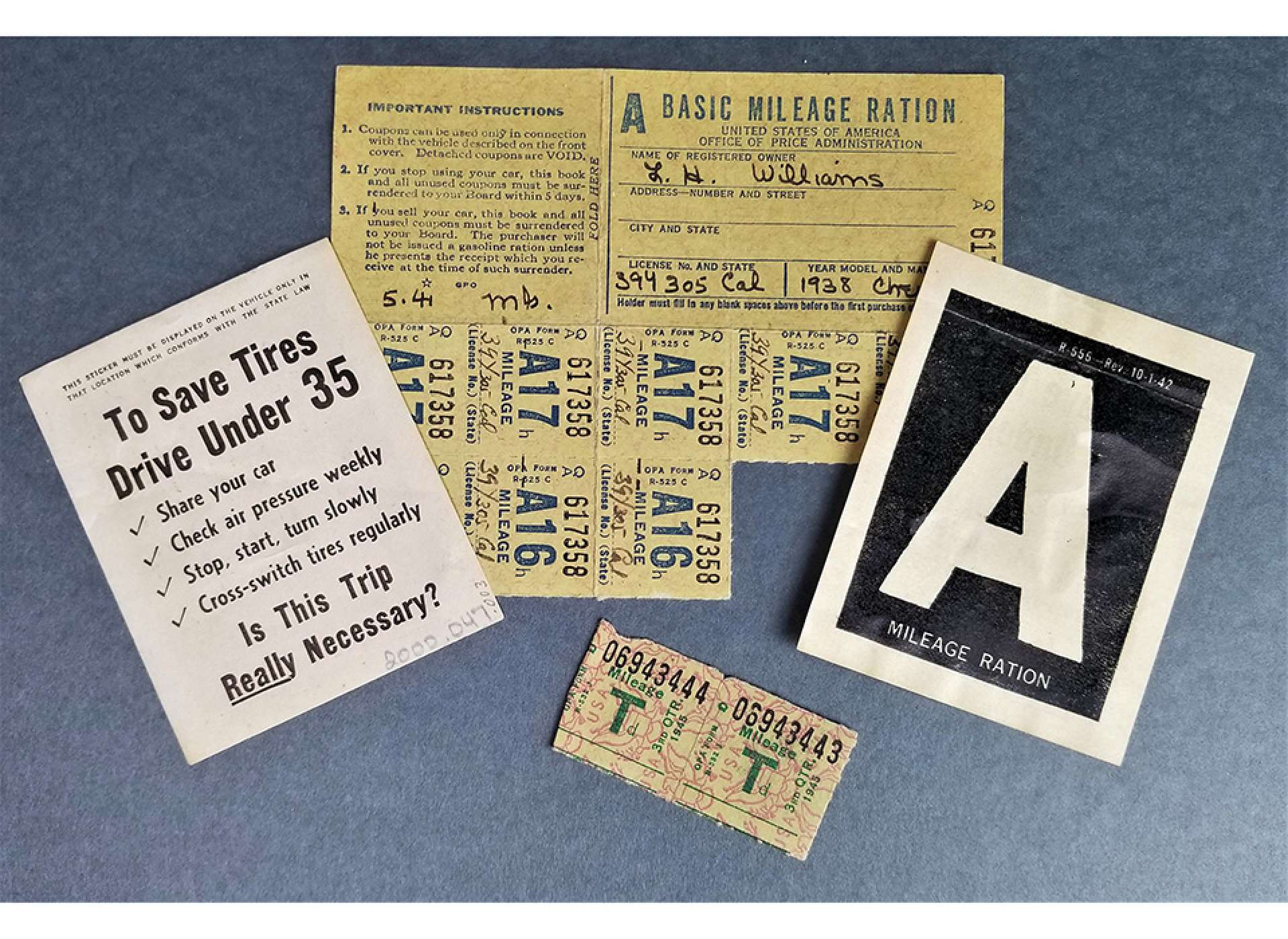
A collection of mileage ration stamps and stickers for L.H. Williams’ 1938 Chevrolet. The National WWII Museum, Gift of Paula Ussery, 2000.047.
Four gallons was not much. It seems like even less when you consider the average mileage on late 1930s automobiles. A six-cylinder 1939 Chevrolet Master weighed just under 3,000 pounds and averaged around 18 miles a gallon. With an A sticker on the windshield, it could travel 72 miles over the entire week. Depending on a worker’s schedule, they could live no more than six or seven miles away from the plant or they had to make other arrangements. The idea of driving to see grandma or crossing half a state to visit a National Park was out of the question through much of the war. Even a small diversion could invite trouble.
Grumman ran a warning to workers, showing a photo of a Nassau police lieutenant questioning a factory worker who had strayed five blocks from his work-to-home route. Nassau and Suffolk police told Grumman there would be no “second chances” for drivers. The Sunday before, five Grummanites had been caught “joyriding” and permanently lost their gas ration coupons. Police were known to cruise the parking lots of taverns, bowling centers, and “other places of amusement” for cars that were out of place.
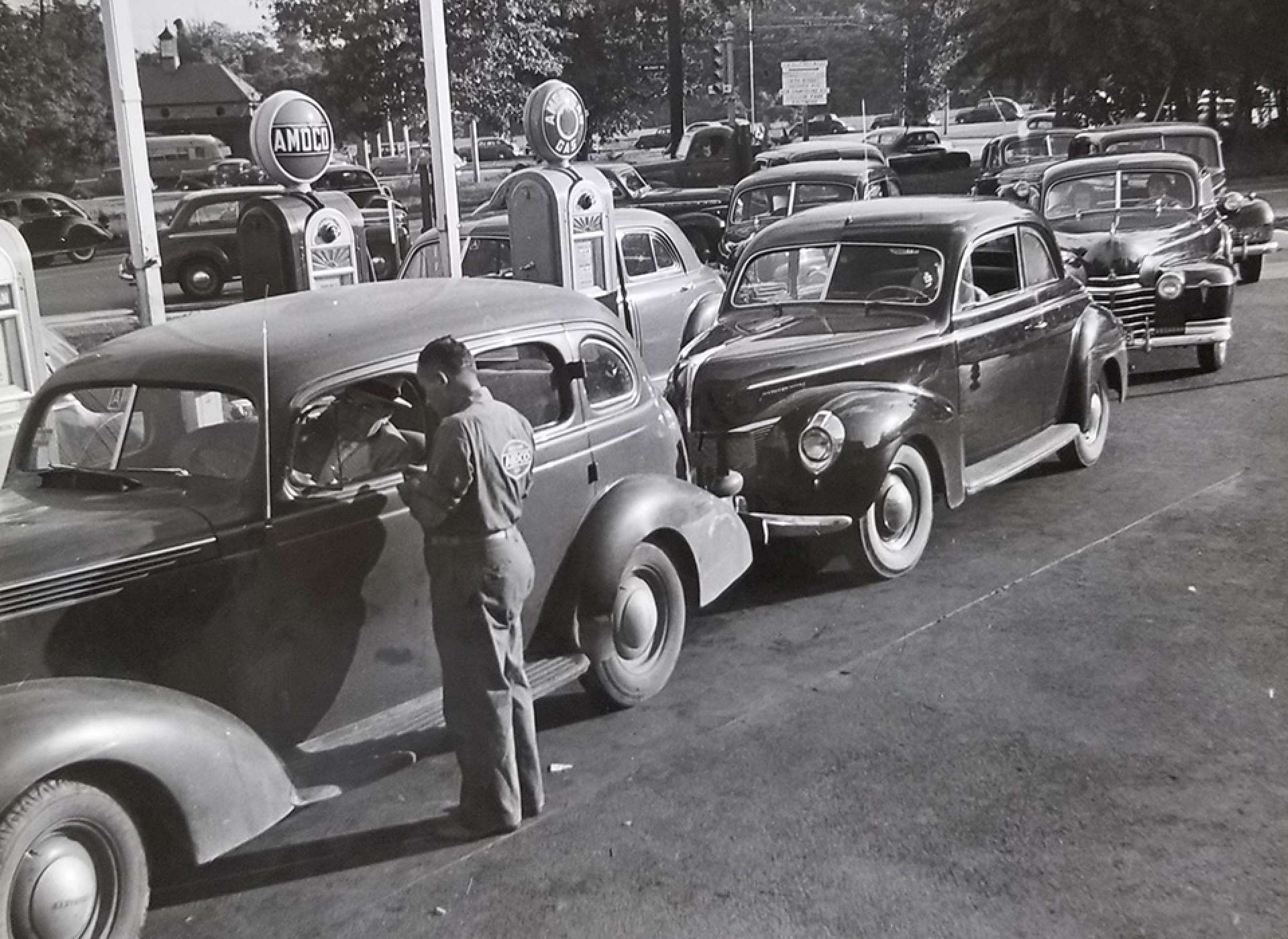
In July 1942, drivers jockey into position to await a fill-up in Washington DC. The line-up of cars began to develop hours before the station opened. Courtesy Library of Congress.
Another sticker in the windshield of WWII automobiles was a Wartime Motor Vehicle Use Tax stamp—a new one every month. The tax varied by the time of the year, drivers paying between 42 cents (June) and five dollars (July) per month to own and operate their car. July’s $5 fee was roughly equivalent to $76.00 in today’s dollars. The tax on automobiles in America was initiated from February of 1942 and lasted until well after the war had ended, in June of 1946. For those who paid for their car monthly throughout the entire war (and beyond) they shelled out $136.43, equal to roughly $2,080 in 2021 dollars.
Fees, frustrations, and slowly fading tires curtailed the number of private cars on the road significantly. By 1945, household car ownership in the US had dipped to around 73 percent (from 88 percent in 1941), a rate roughly equal to Great Depression numbers of 1935 and 1936. Some war workers, fed up with the headaches involved, parked their cars “for the duration.” For those firmly committed to keeping their trusty automobiles, carpooling was inevitable. Others switched to buses, streetcars, or their bicycles.
Stubborn drivers soldiered on with dying jalopies. So many aircraft manufacturing employees had such horrifically bad cars that the people of Grumman turned their shame into a contest. Night shift worker Harold Boit and his hideous 1927 Chevy came in second to Robert Roxborough from the receiving department. Bob’s car was a relatively new 1940 Chevrolet sedan, but it had been ravaged in a nearly-fatal tangle with a Long Island bus. All the sheet metal forward of the windshield had been ripped away, leaving the engine and radiator rushing through the wind between two ever-more-balding tires.
Ancient varieties of tires were not rationed, leading some workers to appropriate outdated Ford Model T type automobiles. Model Ts debuted in 1908. As Douglas’ periodical put it, “nobody will steal it and he can eventually sell it to the movies, if it does not fall apart on him some day.”
Goodyear employee Donald Ladd had a Model T nicknamed “the vibrator.” He bought it for $10 because the original owner preferred that the machine not go into the junk pile. The 1923 vintage automobile never let Ladd down, even chugging to work in sub-zero Ohio temperatures.
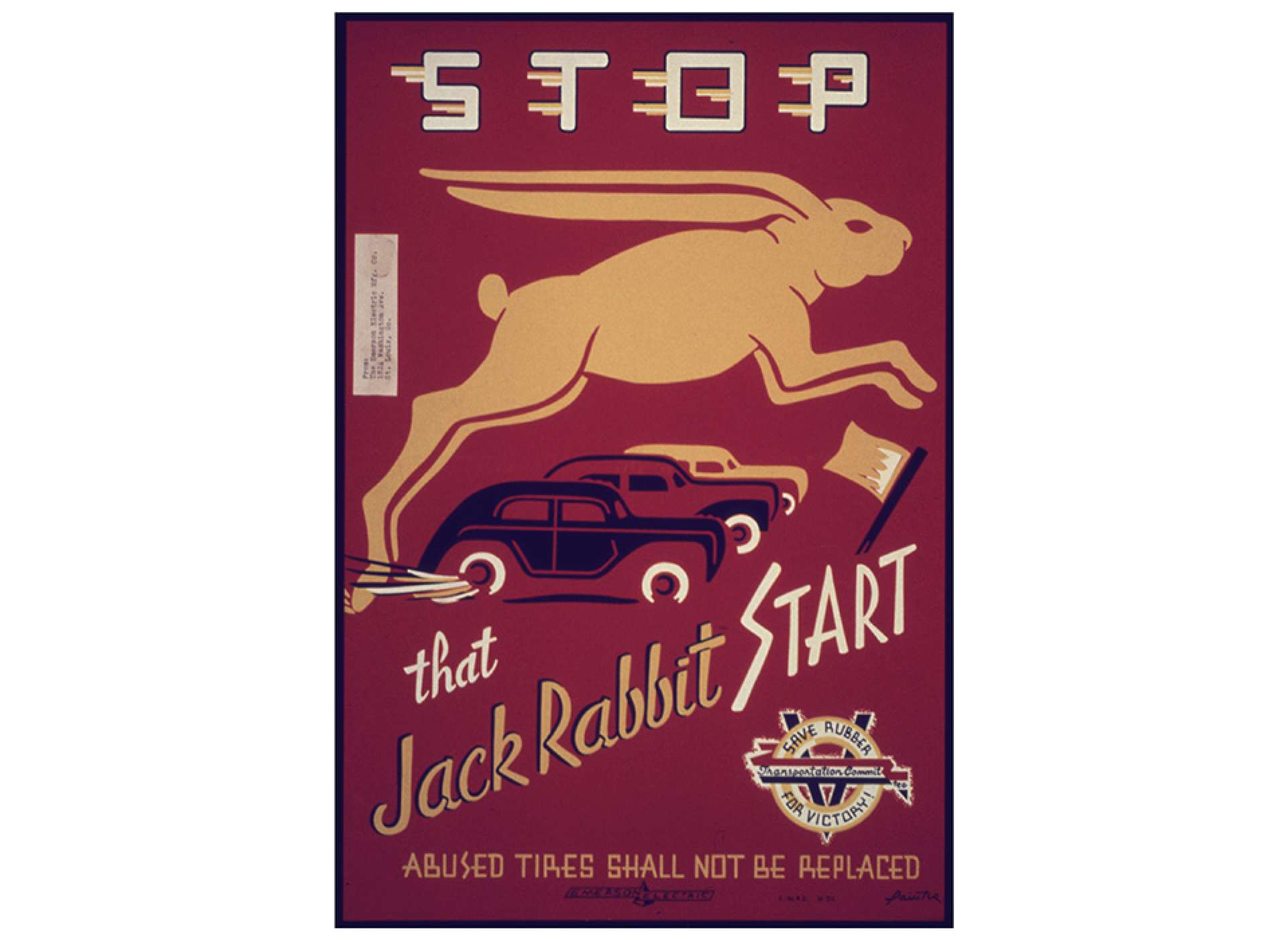
An Emerson Electric poster implores drivers to take it easy on their gas-guzzling starts. The St. Louis company made millions of brass shell casings and built gun turrets during World War II. Courtesy National Archives.
A pair of Bell employees in Georgia had the opposite results. James Anderson and Albert Guimares had a 1918 Model T that “made it to Marietta in three breakdowns, and made it back to Atlanta in two.” They were anxious to find additional riders, but figured they might have to “put the shoe on the other foot” and offered $2.50 a week to come along. The machine had a kerosene lamp for a tail light and heartily protested every incline. They had to push nearly as often as they rode. “It’s not a case of our wearing the jalopy out,” said Anderson, “it’s a case of the jalopy wearing us out.”
When the war came to an end, America was hungry for new cars. Returning soldiers and sailors wanted them, and civilians, nursing dying vehicles from 1942 to 1945, needed them. Car companies, with more capacity than ever before, were happy to oblige.
When Japan surrendered, there were roughly 26 million cars in the United States. At the dawn of the 1960s, that number had jumped to nearly 60 million. Giving birth to the suburbs, the interstate highway system, drive-in movies, and drive-through restaurants, the prevalence of the automobile in the postwar years changed American life forever.
Cite this article:
MLA Citation:
APA Citation:
Chicago Style Citation:
